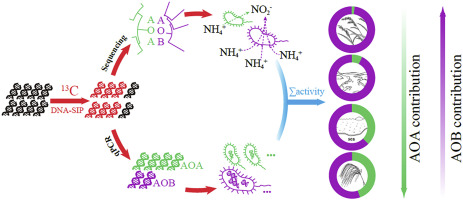当前位置:
X-MOL 学术
›
Water Res.
›
论文详情
Our official English website, www.x-mol.net, welcomes your feedback! (Note: you will need to create a separate account there.)
The abundance and community structure of active ammonia-oxidizing archaea and ammonia-oxidizing bacteria shape their activities and contributions in coastal wetlands.
Water Research ( IF 12.8 ) Pub Date : 2020-01-03 , DOI: 10.1016/j.watres.2019.115464 Chen Wang 1 , Shuangyu Tang 1 , Xiangjun He 1 , Guodong Ji 1
Water Research ( IF 12.8 ) Pub Date : 2020-01-03 , DOI: 10.1016/j.watres.2019.115464 Chen Wang 1 , Shuangyu Tang 1 , Xiangjun He 1 , Guodong Ji 1
Affiliation

|
Aerobic ammonia oxidation, an important part of the global nitrogen cycle, is thought to be jointly driven by ammonia-oxidizing bacteria (AOB) and ammonia-oxidizing archaea (AOA) in coastal wetlands. However, the activities and contributions of AOA and AOB in coastal wetlands have remained largely unknown. Here, we investigated the oxidation capability of AOA and AOB in four types of typical coastal wetlands (paddy, estuary, shallow and reed wetland) in the Bohai region in China using DNA-based stable-isotope probing (DNA-SIP), quantitative PCR and high-throughput sequencing techniques. We found that the community structure of AOB varied substantially, and the AOA structure was more stable across different coastal wetlands. The rate of AOA was 0.12, 0.84, 0.45 and 0.93 μg N g-1 soil d-1 in paddy, estuary, shallow and reed wetlands, and the rate of AOB was 5.61, 10.72, 0.74 and 1.16 μg N g-1 soil d-1, respectively. We found that the contribution of AOA gradually increased from paddy to estuary to shallow wetland and finally to reed wetland, with values of 2.03%, 7.25%, 37.53% and 44.51%, respectively. Our results provide new insight into the mechanisms of the differences in activities and the contributions of AOA and AOB in different coastal wetlands, and our findings may contribute to further understanding of the global nitrogen cycle.
更新日期:2020-01-04



























 京公网安备 11010802027423号
京公网安备 11010802027423号